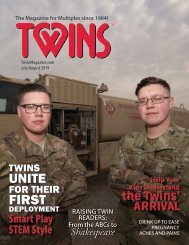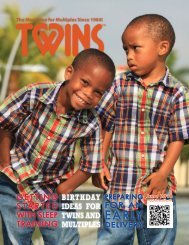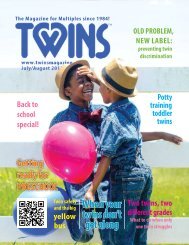2004 Guide To The First Year with Twins
In this edition: Are they twins Back to Sleep Breast feeding Your Twins Does zygosity matter Early Arrivals Getting out and about Getting Started a Basic Layette HELP! I Need Somebody Introducing Solid Foods It's Child's Play Juggling Act…one Mom's story Nicu Primer Protecting Your Child From RSV Pumping Primer SLEEPING Through the NIGHT Teething Times two The best-laid plans The early days The Road to Independece The Twin Bond Weaning Awareness Welcome Home What About Me
In this edition:
Are they twins
Back to Sleep
Breast feeding Your Twins
Does zygosity matter
Early Arrivals
Getting out and about
Getting Started a Basic Layette
HELP! I Need Somebody
Introducing Solid Foods
It's Child's Play
Juggling Act…one Mom's story
Nicu Primer
Protecting Your Child From RSV
Pumping Primer
SLEEPING Through the NIGHT
Teething Times two
The best-laid plans
The early days
The Road to Independece
The Twin Bond
Weaning Awareness
Welcome Home
What About Me
You also want an ePaper? Increase the reach of your titles
YUMPU automatically turns print PDFs into web optimized ePapers that Google loves.
NICU
Primer
When newborn multiples need medical intervention,
they are generally transferred to the neonatal intensive
care unit. A health-care team comprised of neonatologists,
neonatal nurses, pediatricians, pediatric surgeons, pediatric
resident physicians and neonatal respiratory therapists will
be caring for your infants. Additional resources are provided by
social services and pastoral counseling. Here are some issues parents
encounter when infants require a stay in the NICU.
Bonding. Physical and visual contact are very important in
establishing a lasting attachment to your infants. When bonding
is delayed, it can be “made up” through hands-on parenting in
the NICU.
Therapeutic handling. Proper handling of tiny babies can
enhance and encourage relaxation, improve digestion, facilitate
the development of head control and more. The staff will guide
parents in proper techniques.
Kangaroo care. This places the infant skin-to-skin with the
parent. The baby sees, hears, smells and touches his parent while
his temperature is monitored on a regular basis. Studies indicate
this technique may lower infection rates and hasten discharge
times.
Nutrition. Feeding can be a complex challenge with high-risk
infants. Depending on weight and condition, NICU infants may
require intravenous, tube feedings (stomach or nasal) to provide
sufficient caloric intake.
Weight gain. Feedings, by any method, must begin as soon as
possible. Babies are weighed daily, and more often, if they have
fluid imbalances.
Temperature control. A constant temperature is necessary for
survival and is handled aggressively in the NICU.
Oxygen therapy. When infants are on oxygen, they are monitored
very closely, administered blood tests and may require
continuous readings, including transcutaneous monitoring or
pulse oximetry. These methods measure babies’ levels of oxygen
saturation in the blood.
Pain management. By 24 weeks’ gestation, the body processes
that allow painful impulses to be transmitted are completed.
Medication and non-pharmacological measures, such as comfort
measures and positioning, can help manage pain.
Monitors and machines. The electronic eyes of the NICU
watch heart rate, blood pressure and breathing, as well as equipment
function. Never to take the place of constant attention,
monitors are necessary but should be viewed only as part of the
landscape.
Ultrasound. Ultrasound is a non-invasive, fast, painless diagnostic
tool used to investigate clinical problems.
Ventilators. The use of ventilators revolutionized the NICU.
They provide oxygen and assistance with breathing or may actually
breathe for the baby. A tube is placed in the baby’s nose or
mouth, or through the trachea (windpipe).
—Cheryle G. Levitt, R.N., M.S.N.
Co-bedding in the NICU
For twins, there is a natural attachment and only a sibling’s presence
can provide substantial comfort and security. Co-bedding can
offer incredible stress-reducing therapy in times of crisis. Some
observed benefits to co-bedding include:
● Better heart rate and lower oxygen requirements
● Co-regulation of vital signs and body temperature
● Improved physical growth and motor development
● Shorter length of hospital stay
● Decreased hospital readmissions
● Enhanced parent-infant bonding
● Easier transition to home
More NICU articles
TWINS Magazine publishes many stories on life in the NICU and
preemie twins. Among them are:
• “23-week twins Georgia state record,” by Clay Owens,
Special Miracles, July/August 2004
• “Easing the Pain of Tiny Patients,” by Sheree Geyer,
March/April 2002
• “The Emotional Toll of Preemies,” by Jennifer Reising,
July/August 2003
To download copies of these and other stories, visit
www.TwinsMagazine.com
10 GUIDE TO THE FIRST YEAR To subscribe to TWINS call 1-888-55-TWINS or go to www.TwinsMagazine.com

















